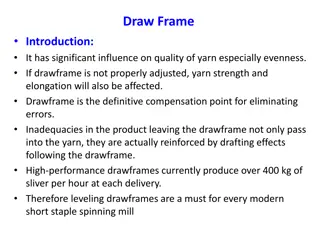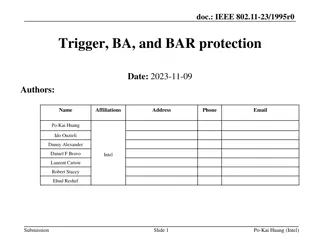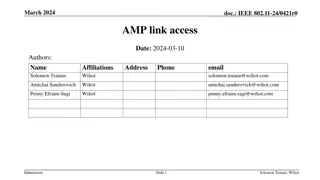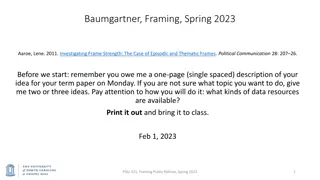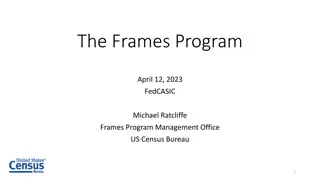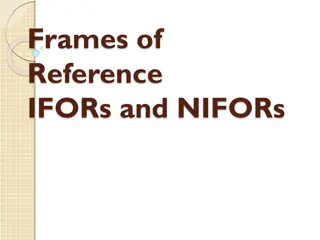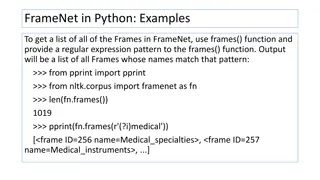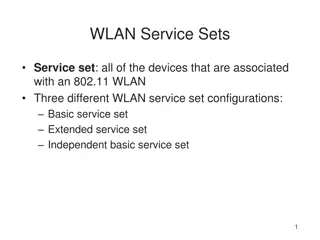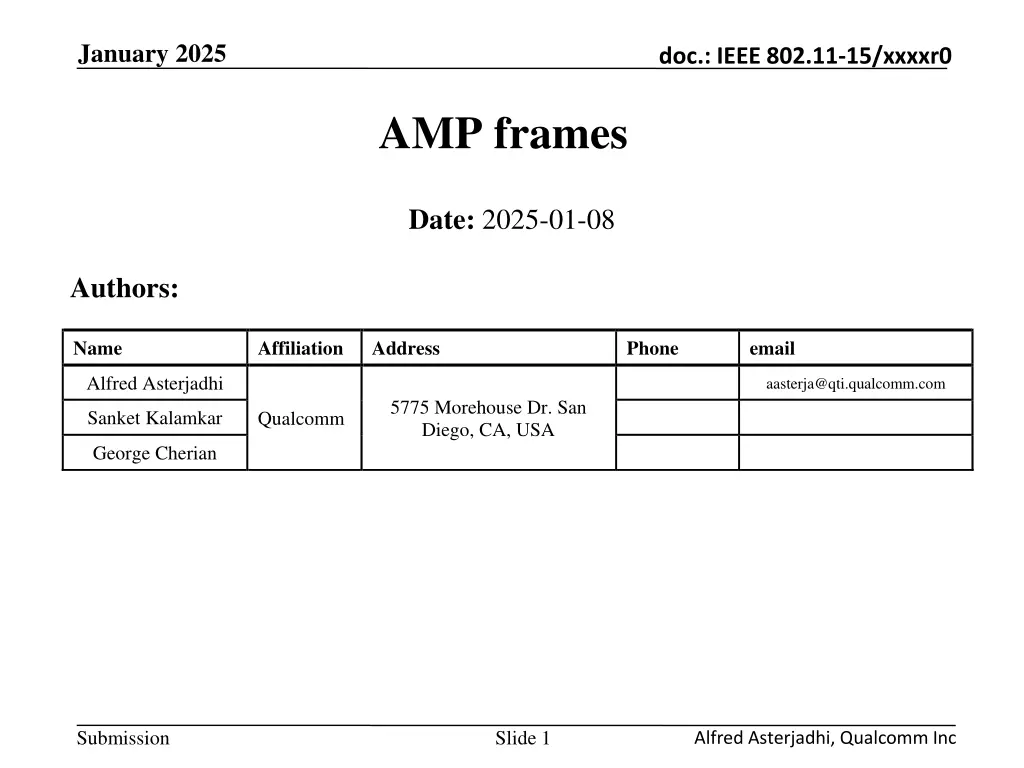
IEEE 802.11 AMP Frame Format Definition Overview
In this document, the authors propose defining the general AMP frame format, inspired by WUR frames, for IEEE 802.11. They aim to keep the formats simple and minimalistic, starting with essential frames like AMP Trigger and AMP Ack. The AMP frames include specific fields like Frame Control, AMP Type, TX ID, RX ID, and more, catering to higher data rates than WUR. Explore the detailed content for insights into the design philosophies and considerations for AMP frames.
Download Presentation

Please find below an Image/Link to download the presentation.
The content on the website is provided AS IS for your information and personal use only. It may not be sold, licensed, or shared on other websites without obtaining consent from the author. If you encounter any issues during the download, it is possible that the publisher has removed the file from their server.
You are allowed to download the files provided on this website for personal or commercial use, subject to the condition that they are used lawfully. All files are the property of their respective owners.
The content on the website is provided AS IS for your information and personal use only. It may not be sold, licensed, or shared on other websites without obtaining consent from the author.
E N D
Presentation Transcript
January 2025 doc.: IEEE 802.11-15/xxxxr0 AMP frames Date: 2025-01-08 Authors: Name Affiliation Address Phone email Alfred Asterjadhi aasterja@qti.qualcomm.com 5775 Morehouse Dr. San Diego, CA, USA Sanket Kalamkar Qualcomm George Cherian Submission Slide 1 Alfred Asterjadhi, Qualcomm Inc
January 2018 doc.: IEEE 802.11-15/xxxxr0 Introduction We propose to define the general AMP frame format Following similar formats and design philosophies to WUR frames We can possibly use the same format as WUR (and use reserved types) We start by designing two essential frames AMP Trigger and AMP Ack While leaving enough flexibility for other AMP frames And keeping the formats very simple and with minimal overhead Note that AMP data rates are expected to be a bit higher than WUR data rates Submission Slide 2 Alfred Asterjadhi, Qualcomm Inc
January 2025 doc.: IEEE 802.11-15/xxxxr0 AMP PPDU Optional Energizer Signal PHY Preamble Frame Body MAC Header FCS AMP frame needs the following fields: A Frame Control to signal (aim at 8 bits long at most, same as WUR): AMP Type: Indicates the type of AMP frame (e.g., Trigger, Ack, etc.) Protected: Indicates whether the FCS field, if present, carries a CRC or MIC Other fields if needed are TBD IDs - target similar principles as 11ba, with appropriate considerations for AMP: One ID for the transmitter and/or one identifier for individual recipient(s), or group of recipients Frame Body can be optionally present This can be enabled if we are interested in variable-length PPDUs We defined similar PPDUs in WUR, albeit optional FCS, is optionally present and contains the CRC or MIC For WUR the FCS field was always present and was 16 bits Submission Slide 3 Alfred Asterjadhi, Qualcomm Inc
January 2025 doc.: IEEE 802.11-15/xxxxr0 AMP Trigger MAC Header Frame Body FCS Frame Control TX ID RX ID Bits 8 X X AMP Trigger is sent to one or more AMP STAs to solicit an AMP PPDU Needs to identify the transmitter (TX ID) and/or the recipient (RX ID) The TX ID identifies the AMP AP and RX ID identifies the AMP STA (or group of AMP STAs) May contain an RX ID list for the group cast case in the Frame Body May contain access policy for TDMA, etc. In case responses are expected by the targeted STAs May contain security related parameters May contain a bit for each of the STAs indicating whether a response is solicited STA sends an AMP response in the specified resource and/or following the specified access rules Etc. Submission Slide 4 Alfred Asterjadhi, Qualcomm Inc
January 2025 doc.: IEEE 802.11-15/xxxxr0 AMP Ack MAC Header Frame Body FCS Frame Control TX ID RX ID Bits 8 X X AMP Ack is sent by one or more AMP STAs in response to an AMP Trigger frame or another AMP frame that is sent by the peer STA and that AMP frame requires an acknowledgment Needs to identify the transmitter (TX ID) (not essential) and the recipient (RX ID) The TX ID identifies the AMP AP The RX ID identifies the AMP STA (or the group of AMP STAs) Can carry other information as well Submission Slide 5 Alfred Asterjadhi, Qualcomm Inc
January 2025 doc.: IEEE 802.11-15/xxxxr0 Summary We provide some MAC level insights on AMP frames and delve into some high-level details on two specific AMP frames that we would benefit from having defined in TGbp AMP Trigger frame AMP Ack frame Submission Slide 6 Alfred Asterjadhi, Qualcomm Inc
January 2025 doc.: IEEE 802.11-15/xxxxr0 Straw Poll 1 Do you agree that 802.11bp defines an AMP Trigger frame that an AP transmits to solicit UL AMP PPDU(s) from one or more 802.11bp clients and carries the following content? Transmitter ID Receiver ID(s) Medium access related policy (e.g., Slotted ALOHA parameters) Security parameters (e.g., ANonce, MIC, etc.) Other parameters TBD FCS Submission Slide 7 Alfred Asterjadhi, Qualcomm Inc
January 2025 doc.: IEEE 802.11-15/xxxxr0 Straw Poll 2 Do you agree that when the AP solicits UL AMP PPDUs from 802.11bp clients using Slotted ALOHA, the AMP Trigger frame shall carry the following parameters? Number of slots for UL AMP PPDU transmissions in that TXOP The probability with which an 802.11bp client attempts to access a slot until it successfully does so Other parameters TBD NOTE The probability can be determined by the AP, and its value selection depends on the implementation. Submission Slide 8 Alfred Asterjadhi, Qualcomm Inc
January 2025 doc.: IEEE 802.11-15/xxxxr0 Straw Poll 3 Do you agree that 802.11bp defines an AMP Ack frame that an AMP STA transmits to acknowledge a soliciting AMP PPDU sent by a peer AMP STA? Submission Slide 9 Alfred Asterjadhi, Qualcomm Inc


